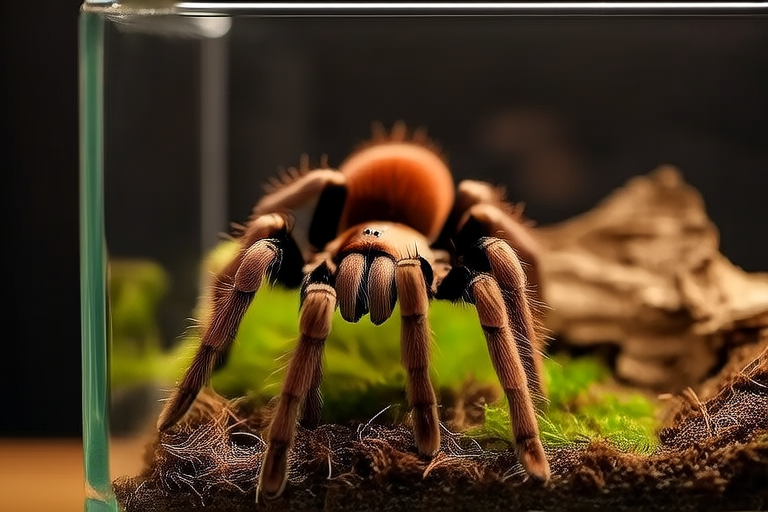Top Secrets to Keeping Your Chilean Rose Tarantula Happy and Healthy at Home
Welcome to the fascinating world of tarantula ownership! If you’re considering adopting a Chilean Rose Tarantula, or if you’ve already welcomed one into your home, you’re embarking on an exciting journey. These arachnids, with their vibrant pink hues when young and rich brown tones as they mature, are among the most popular pets for enthusiasts. However, ensuring their happiness and health requires more than just a basic terrarium. This guide will walk you through essential tips on habitat setup, temperature and humidity control, diet specifics, handling precautions, and signs of good health. We’ll also discuss common mistakes to avoid and the importance of regular observation for early detection of health issues.
Habitat Setup: Mimicking Natural Environments
The first step in keeping your Chilean Rose Tarantula happy and healthy is creating an appropriate habitat. In their natural habitat, these tarantulas live in burrows within arid regions of South America. Therefore, it’s crucial to replicate this environment as closely as possible. Start by selecting an enclosure that is at least three times the length of your tarantula. A glass tank with a secure lid is ideal, as it allows for easy observation while preventing escapes.
Inside the enclosure, add a substrate layer of coconut fiber or sphagnum moss, which can hold moisture well and mimic the soil found in their natural habitats. Include a hide spot, such as a cork bark or half-log, where your tarantula can retreat and feel safe. Additionally, place a shallow water dish filled with clean water for hydration. Ensure the enclosure has adequate ventilation to prevent mold growth.
Temperature and Humidity Control
Maintaining the right temperature and humidity levels is vital for your tarantula’s well-being. Chilean Rose Tarantulas thrive in temperatures ranging from 75°F to 85°F (24°C to 29°C). Use a thermometer to monitor the temperature inside the enclosure and adjust heating sources as necessary. A heat mat placed under one side of the tank can help maintain a gradient, allowing your tarantula to move to cooler areas if needed.
Humidity should be kept between 60% and 80%. Achieve this by misting the enclosure daily or using a humidifier. Avoid over-misting, as excessive moisture can lead to respiratory problems and mold growth. Regularly check the humidity level with a hygrometer to ensure it stays within the recommended range.
Diet Specifics: Feeding Your Tarantula Properly
Chilean Rose Tarantulas are carnivorous and require a varied diet to stay healthy. Feed them appropriately sized prey items such as crickets, mealworms, and dubia roaches. The prey should be no larger than half the width of the tarantula’s abdomen. Offer food every 7 to 10 days for adults, adjusting the frequency based on your tarantula’s activity level and size.
Before feeding, gut-load the prey insects with nutritious foods like fruits, vegetables, and commercial insect diets. This ensures that your tarantula receives maximum nutritional benefits. Additionally, dust the prey with calcium and vitamin supplements to support bone and muscle development.
Handling Precautions: Ensuring Safety and Comfort
While Chilean Rose Tarantulas are generally docile, they can become stressed or defensive if handled improperly. Always wash your hands before and after handling to remove any oils or residues that could harm your tarantula. Gently coax your tarantula out of its hide spot using a soft tool, such as a paintbrush, rather than picking it up directly.
Handle your tarantula infrequently, as excessive handling can cause stress and increase the risk of molting complications. If you must handle your tarantula, do so slowly and gently, supporting its body weight to avoid injury. Never grab or squeeze your tarantula, as this can lead to regurgitation or leg loss.
Signs of Good Health: What to Look For
A healthy Chilean Rose Tarantula exhibits certain behaviors and physical characteristics. It should be active during the night, when tarantulas typically hunt, and remain relatively still during the day. Its abdomen should be rounded and plump, indicating proper nutrition. Additionally, its fangs and mouth area should appear clean and free of debris.
Regularly inspect your tarantula for any signs of illness, such as lethargy, refusal to eat, or unusual shedding patterns. If you notice any concerning symptoms, consult a veterinarian specializing in exotic animals for guidance.
Common Mistakes to Avoid
One of the most common mistakes made by new tarantula owners is overfeeding. Excessive food can lead to obesity and other health issues. Another frequent error is neglecting the tarantula’s need for privacy. Provide ample hiding spots to ensure your tarantula feels secure and less stressed.
Additionally, many owners fail to properly acclimate their tarantulas to their new environment. Acclimation involves gradually introducing the tarantula to its new home over several days, ensuring that all environmental factors are stable and comfortable. Rushing this process can cause undue stress and potential health issues.
Maintaining a Stress-Free Environment
To keep your tarantula stress-free, minimize disturbances in its environment. Avoid placing the enclosure in high-traffic areas or near loud appliances. Keep the lighting consistent and avoid sudden changes in temperature or humidity. Regular maintenance, such as cleaning the enclosure and replacing substrate, helps prevent the buildup of harmful bacteria and parasites.
Regular observation is key to maintaining a stress-free environment. Spend time watching your tarantula’s behavior and noting any changes. Early detection of health issues allows for prompt intervention, improving the chances of successful treatment.
Conclusion: A Rewarding Journey
Owning a Chilean Rose Tarantula can be a rewarding experience, offering a unique opportunity to connect with these fascinating creatures. By following the tips outlined in this guide, you can ensure your tarantula lives a long, healthy, and happy life. Remember to mimic its natural environment, maintain optimal temperature and humidity levels, provide a balanced diet, handle with care, and regularly observe for signs of good health. With patience and dedication, you’ll enjoy a fulfilling relationship with your pet tarantula.
